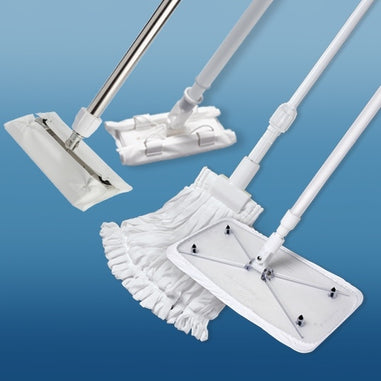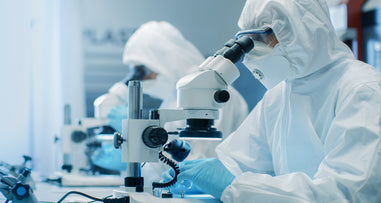- No products in the cart.
Starting a cleanroom lab can be an overwhelming task, especially when it comes to selecting the necessary equipment, personal protective equipment (PPE), and lab supplies. A cleanroom lab starter kit can help streamline the process and ensure that you have everything you need to get started. In this blog, we will discuss the essential equipment, PPE, and lab supplies needed to start a cleanroom lab.
Cleanroom Lab Equipment
1. Laminar Flow Hood
The laminar flow hood is a critical piece of equipment in any cleanroom lab. It provides a localized clean air environment for handling samples or preparing solutions, preventing contamination from surrounding areas. Laminar flow hoods come in different sizes and configurations, and the choice will depend on your specific needs.
2. Autoclave
An autoclave is used to sterilize equipment, media, and other items before entering the cleanroom lab. Autoclaves use high temperature and pressure to kill bacteria, viruses, and other microorganisms, ensuring that the lab remains contamination-free.
3. Microscopes
Microscopes are essential for examining samples and cultures in a cleanroom lab. They come in different types, including compound, stereo, and digital microscopes, and the choice will depend on the application and level of magnification required.
4. Incubator
Incubators are used to culture and grow microorganisms and cells under controlled conditions, such as temperature, humidity, and CO2 levels. They are essential in microbiology, molecular biology, and cell biology applications.
5. Water Purification System
A water purification system is necessary to provide high-quality water for use in the lab. This includes deionized, distilled, or reverse osmosis water, depending on the specific application.
Cleanroom PPE
1. Lab Coats
A lab coat is essential to protect the wearer's clothing and prevent contamination of the cleanroom lab. It should be made of a material that is durable, comfortable, and easy to clean.
2. Cleanroom Gloves
Cleanroom Gloves are essential to prevent contamination from the wearer's hands. They should be cleanroom rated, made of a material that is resistant to chemicals and punctures and should be changed regularly to prevent cross-contamination.
3. Face Mask
A face mask is necessary to prevent the spread of droplets and airborne contaminants. It should be made of a material that is comfortable, breathable, and effective in preventing the spread of contaminants.
4. Shoe Covers
Shoe covers are essential to prevent contaminants from entering the cleanroom lab on the soles of shoes. They should be made of a material that is durable and resistant to slips and should be changed regularly to prevent cross-contamination.
Cleanroom Lab Supplies
1. Sterile Pipettes and Tips
Sterile pipettes and tips are necessary to handle and transfer small volumes of liquids without contamination. They should be made of a material that is chemically resistant and sterile.
2. Petri Dishes
Petri dishes are essential for culturing and growing microorganisms. They should be made of a material that is transparent, sterile, and easy to use.
3. Agar Plates
Agar plates are necessary for microbiology applications, providing a solid surface for microorganisms to grow. They should be made of a material that is sterile, transparent, and easy to use.
4. Culture Tubes
Culture tubes are used for culturing and growing microorganisms, cells, and tissues. They should be made of a material that is sterile, transparent, and resistant to chemicals.
5. Lab Wipes
Lab wipes are essential for cleaning surfaces and equipment in the cleanroom lab. They should be made of a material that is low-linting, absorbent, and chemically resistant.
6. Cleaning Solutions
Cleaning solutions are necessary to clean and disinfect surfaces and equipment in the cleanroom lab. They should be made of a material that is effective in killing microorganisms and is safe for use in a cleanroom environment.
7. Media and Reagents
Media and reagents are essential for performing experiments in the cleanroom lab. They should be made of a material that is sterile and of high quality, ensuring accurate results.
Starting a cleanroom lab requires careful planning and consideration of the necessary equipment, PPE, and lab supplies. A cleanroom lab starter kit can help streamline the process and ensure that you have everything you need to get started. However, it is important to keep in mind that the specific equipment and supplies required will depend on the type of experiments you plan to perform in the cleanroom lab.
In addition to the essential equipment, PPE, and lab supplies listed above, it is also important to consider the layout of the cleanroom lab. The layout should be designed to minimize contamination and ensure that the flow of people, materials, and equipment is streamlined. It should also be equipped with HEPA filters, which are essential in maintaining the air quality within the cleanroom lab.
When starting a cleanroom lab, it is also important to establish a set of standard operating procedures (SOPs) that outline the proper use of equipment, PPE, and lab supplies. This will ensure that all personnel working in the cleanroom lab are trained on the proper procedures, minimizing the risk of contamination.
In conclusion, starting a cleanroom lab requires careful consideration of the necessary equipment, PPE, and lab supplies. A cleanroom lab starter kit can help streamline the process and ensure that you have everything you need to get started. However, it is important to keep in mind that the specific equipment and supplies required will depend on the type of experiments you plan to perform in the cleanroom lab. By following best practices and establishing SOPs, you can maintain a contamination-free environment and ensure the accuracy of your results.
For over 40 years, Lab Pro Inc. has been committed to delivering the highest quality cleanroom lab supplies distance learning kits, lab supplies, chemicals, and cleanroom PPE apparel to teaching institutions and laboratories worldwide. To learn more, visit the biggest Lab Supply demoroom in California, or contact us online or at 888-452-2776.












































